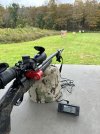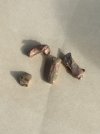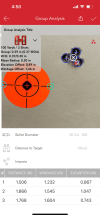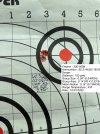Looking forward to the Range report!
You are using an out of date browser. It may not display this or other websites correctly.
You should upgrade or use an alternative browser.
You should upgrade or use an alternative browser.
Badlands Precision Bullets thread - From BC to terminal ballistics
- Thread starter codyadams
- Start date
 Help Support Long Range Hunting Forum
Help Support Long Range Hunting Forum
Lovellr653
Well-Known Member
Okay I finally snuck out of the house for a quick range session. Started with 77.0gr Retumbo and worked up to 80.0gr. I got first signs of pressure in the form of ejector marks on the Lapua brass at 79.5gr and definite marks at 80.0. My best group was with 79.0 grains with a MV of 2891fps with a SD of 5.6 and ES of 8. Granted this was just a 3 shot group so I suspect that'll open some with a 10 shot group. These 195 BD-2's are 0.020" off the lands. With a 22" barrel I'm pleased with the velocities I was getting. I really don't see much need to tune anything else at this point but time will tell. I found a few chunks of bullet in the clay/rock outcropping behind the target, pretty robust bullets. I could probably play around a bit with seating depth but personally I could benefit from more time behind the rifle and not the bench. I've never been real good at shooting groups and I definitely need to work on shooting fundamentals. Also curious how the groups will react without the magneto speed attached.
Attachments
I have seen groups shrink and increase in size after taking off my Magneto. Only way to know is to do itOkay I finally snuck out of the house for a quick range session. Started with 77.0gr Retumbo and worked up to 80.0gr. I got first signs of pressure in the form of ejector marks on the Lapua brass at 79.5gr and definite marks at 80.0. My best group was with 79.0 grains with a MV of 2891fps with a SD of 5.6 and ES of 8. Granted this was just a 3 shot group so I suspect that'll open some with a 10 shot group. These 195 BD-2's are 0.020" off the lands. With a 22" barrel I'm pleased with the velocities I was getting. I really don't see much need to tune anything else at this point but time will tell. I found a few chunks of bullet in the clay/rock outcropping behind the target, pretty robust bullets. I could probably play around a bit with seating depth but personally I could benefit from more time behind the rifle and not the bench. I've never been real good at shooting groups and I definitely need to work on shooting fundamentals. Also curious how the groups will react without the magneto speed attached.
Hiwayman92
Well-Known Member
EXCELLENT. What twist rate is your rig and how far off the lands are you?20" 300 WSM update. It has been a while, but after switching to ADG brass everything is coming together. I need to verify this load, but I've got 195's running at 2860 with H4350, with a SD of 3.4.
Last edited:
Hiwayman92
Well-Known Member
I'm about .030 off and it's a 1:10 twist at 6550 feet of altitude. I have the CBTO measurement somewhere, but I've been referencing COL to check for seating depth variations with the crunchy load. I've also been using a 4" drop tube to help out.
Short or long action?I'm about .030 off and it's a 1:10 twist at 6550 feet of altitude. I have the CBTO measurement somewhere, but I've been referencing COL to check for seating depth variations with the crunchy load. I've also been using a 4" drop tube to help out.
Not trying to be the spoiler, but I've now had two (2) Badlands Precision Bulldozer bullets, and one (1) Cutting Edge Lazer bullet, corkscrew off-course in three (3) different game animals.
Two were in bull moose, and one in a bull caribou.
I don't mean a little off course. I mean a 60 to 80-degree deviation from straight-line penetration!
One bull moose was hit in the spine behind the shoulder with a .338 275gr BD bullet. Bullet was recovered under the hide, near his butt-hole. Bull moose was standing broadside when bullet struck him. This bullet traveled about 4 1/2 feet inside the animal. My SG value on this bullet was calculated at 1.26
Another bull moose was hit just behind the liver, mid-height on the body, with a .338 265gr Cutting Edge Lazer bullet. Bullet was recovered in the off-side front shoulder meat. This bullet hit no heavy bone on entry side. Possibly hit one of the small rearward ribs upon entry, at the most. Profile of this bull moose when shot, was again, completely broadside. This bullet traveled a distance of about 4 feet inside the animal. My SG value on this bullet was calculated at 1.41
Bull caribou was hit mid-height in the ribs, just behind the front shoulder muscle, with a .308 196.5gr Badlands Bulldozer bullet. Bull caribou was completely broadside when this bullet entered his body. The bullet exited the offside rear ham, in front of the rear leg bone. Bullet traveled a distance of about 3 1/2 feet inside the animal before exiting out the offside rear ham muscle. No heavy bone contact during bullet travel through this animal. Bullet could have hit a rib on the entry side of his rib cage. My SG value on this bullet was calculated at 1.40
If you plan to hunt large game with copper mono bullets, I recommend shooting them from a barrel with a twist rate sufficient to provide a bullet stability (SG value) of at least 1.75
And I feel a SG value of 2.0 would be even better. Because I've read on this Forum that Hammer Bullets recommends a minimum SG value of 2.0 with their copper bullets, to help ensure straight-line bullet penetration.
How copper mono bullets can corkscrew off-course from straight-line penetration as much as 80 degrees, and still penetrate 4 1/2 feet? I dunno. It's both dumbfounding, and amazing! Just about have to see it firsthand, in order to believe it.
Two were in bull moose, and one in a bull caribou.
I don't mean a little off course. I mean a 60 to 80-degree deviation from straight-line penetration!
One bull moose was hit in the spine behind the shoulder with a .338 275gr BD bullet. Bullet was recovered under the hide, near his butt-hole. Bull moose was standing broadside when bullet struck him. This bullet traveled about 4 1/2 feet inside the animal. My SG value on this bullet was calculated at 1.26
Another bull moose was hit just behind the liver, mid-height on the body, with a .338 265gr Cutting Edge Lazer bullet. Bullet was recovered in the off-side front shoulder meat. This bullet hit no heavy bone on entry side. Possibly hit one of the small rearward ribs upon entry, at the most. Profile of this bull moose when shot, was again, completely broadside. This bullet traveled a distance of about 4 feet inside the animal. My SG value on this bullet was calculated at 1.41
Bull caribou was hit mid-height in the ribs, just behind the front shoulder muscle, with a .308 196.5gr Badlands Bulldozer bullet. Bull caribou was completely broadside when this bullet entered his body. The bullet exited the offside rear ham, in front of the rear leg bone. Bullet traveled a distance of about 3 1/2 feet inside the animal before exiting out the offside rear ham muscle. No heavy bone contact during bullet travel through this animal. Bullet could have hit a rib on the entry side of his rib cage. My SG value on this bullet was calculated at 1.40
If you plan to hunt large game with copper mono bullets, I recommend shooting them from a barrel with a twist rate sufficient to provide a bullet stability (SG value) of at least 1.75
And I feel a SG value of 2.0 would be even better. Because I've read on this Forum that Hammer Bullets recommends a minimum SG value of 2.0 with their copper bullets, to help ensure straight-line bullet penetration.
How copper mono bullets can corkscrew off-course from straight-line penetration as much as 80 degrees, and still penetrate 4 1/2 feet? I dunno. It's both dumbfounding, and amazing! Just about have to see it firsthand, in order to believe it.
Hiwayman92
Well-Known Member
Short action M70, so it's a little longer than most factory SA's.Short or long action?
akmtnhnt
Well-Known Member
Even with lead bullets a bare minimum of 1.5 is recommended for optimal BC and terminal stability, but it's going to punch holes in paper fine.Not trying to be the spoiler, but I've now had two (2) Badlands Precision Bulldozer bullets, and one (1) Cutting Edge Lazer bullet, corkscrew off-course in three (3) different game animals.
Two were in bull moose, and one in a bull caribou.
I don't mean a little off course. I mean a 60 to 80-degree deviation from straight-line penetration!
One bull moose was hit in the spine behind the shoulder with a .338 275gr BD bullet. Bullet was recovered under the hide, near his butt-hole. Bull moose was standing broadside when bullet struck him. This bullet traveled about 4 1/2 feet inside the animal. My SG value on this bullet was calculated at 1.26
Another bull moose was hit just behind the liver, mid-height on the body, with a .338 265gr Cutting Edge Lazer bullet. Bullet was recovered in the off-side front shoulder meat. This bullet hit no heavy bone on entry side. Possibly hit one of the small rearward ribs upon entry, at the most. Profile of this bull moose when shot, was again, completely broadside. This bullet traveled a distance of about 4 feet inside the animal. My SG value on this bullet was calculated at 1.41
Bull caribou was hit mid-height in the ribs, just behind the front shoulder muscle, with a .308 196.5gr Badlands Bulldozer bullet. Bull caribou was completely broadside when this bullet entered his body. The bullet exited the offside rear ham, in front of the rear leg bone. Bullet traveled a distance of about 3 1/2 feet inside the animal before exiting out the offside rear ham muscle. No heavy bone contact during bullet travel through this animal. Bullet could have hit a rib on the entry side of his rib cage. My SG value on this bullet was calculated at 1.40
If you plan to hunt large game with copper mono bullets, I recommend shooting them from a barrel with a twist rate sufficient to provide a bullet stability (SG value) of at least 1.75
And I feel a SG value of 2.0 would be even better. Because I've read on this Forum that Hammer Bullets recommends a minimum SG value of 2.0 with their copper bullets, to help ensure straight-line bullet penetration.
How copper mono bullets can corkscrew off-course from straight-line penetration as much as 80 degrees, and still penetrate 4 1/2 feet? I dunno. It's both dumbfounding, and amazing! Just about have to see it firsthand, in order to believe it.
I would have told you don't use those bullets with those barrels if the SG was that low.
RockyMtnMT
Official LRH Sponsor
We calculate our minimum twist rate for our bullets at 1.5sg calculated at standard atmosphere at sea level. This is based on making sure there is enough stability for proper terminal performance and has nothing to do with ballistic performance. We consider this to be a true minimum and if possible higher stability is preferable.Not trying to be the spoiler, but I've now had two (2) Badlands Precision Bulldozer bullets, and one (1) Cutting Edge Lazer bullet, corkscrew off-course in three (3) different game animals.
Two were in bull moose, and one in a bull caribou.
I don't mean a little off course. I mean a 60 to 80-degree deviation from straight-line penetration!
One bull moose was hit in the spine behind the shoulder with a .338 275gr BD bullet. Bullet was recovered under the hide, near his butt-hole. Bull moose was standing broadside when bullet struck him. This bullet traveled about 4 1/2 feet inside the animal. My SG value on this bullet was calculated at 1.26
Another bull moose was hit just behind the liver, mid-height on the body, with a .338 265gr Cutting Edge Lazer bullet. Bullet was recovered in the off-side front shoulder meat. This bullet hit no heavy bone on entry side. Possibly hit one of the small rearward ribs upon entry, at the most. Profile of this bull moose when shot, was again, completely broadside. This bullet traveled a distance of about 4 feet inside the animal. My SG value on this bullet was calculated at 1.41
Bull caribou was hit mid-height in the ribs, just behind the front shoulder muscle, with a .308 196.5gr Badlands Bulldozer bullet. Bull caribou was completely broadside when this bullet entered his body. The bullet exited the offside rear ham, in front of the rear leg bone. Bullet traveled a distance of about 3 1/2 feet inside the animal before exiting out the offside rear ham muscle. No heavy bone contact during bullet travel through this animal. Bullet could have hit a rib on the entry side of his rib cage. My SG value on this bullet was calculated at 1.40
If you plan to hunt large game with copper mono bullets, I recommend shooting them from a barrel with a twist rate sufficient to provide a bullet stability (SG value) of at least 1.75
And I feel a SG value of 2.0 would be even better. Because I've read on this Forum that Hammer Bullets recommends a minimum SG value of 2.0 with their copper bullets, to help ensure straight-line bullet penetration.
How copper mono bullets can corkscrew off-course from straight-line penetration as much as 80 degrees, and still penetrate 4 1/2 feet? I dunno. It's both dumbfounding, and amazing! Just about have to see it firsthand, in order to believe it.
My son had that happen with a mono in Texas on an Aoudad in February. Neither brand you mentioned but he hit it in the knuckle. The bullet took a hard right turn probably 60 degrees and came out its neck. It only took a few steps and dropped though.Not trying to be the spoiler, but I've now had two (2) Badlands Precision Bulldozer bullets, and one (1) Cutting Edge Lazer bullet, corkscrew off-course in three (3) different game animals.
Two were in bull moose, and one in a bull caribou.
I don't mean a little off course. I mean a 60 to 80-degree deviation from straight-line penetration!
One bull moose was hit in the spine behind the shoulder with a .338 275gr BD bullet. Bullet was recovered under the hide, near his butt-hole. Bull moose was standing broadside when bullet struck him. This bullet traveled about 4 1/2 feet inside the animal. My SG value on this bullet was calculated at 1.26
Another bull moose was hit just behind the liver, mid-height on the body, with a .338 265gr Cutting Edge Lazer bullet. Bullet was recovered in the off-side front shoulder meat. This bullet hit no heavy bone on entry side. Possibly hit one of the small rearward ribs upon entry, at the most. Profile of this bull moose when shot, was again, completely broadside. This bullet traveled a distance of about 4 feet inside the animal. My SG value on this bullet was calculated at 1.41
Bull caribou was hit mid-height in the ribs, just behind the front shoulder muscle, with a .308 196.5gr Badlands Bulldozer bullet. Bull caribou was completely broadside when this bullet entered his body. The bullet exited the offside rear ham, in front of the rear leg bone. Bullet traveled a distance of about 3 1/2 feet inside the animal before exiting out the offside rear ham muscle. No heavy bone contact during bullet travel through this animal. Bullet could have hit a rib on the entry side of his rib cage. My SG value on this bullet was calculated at 1.40
If you plan to hunt large game with copper mono bullets, I recommend shooting them from a barrel with a twist rate sufficient to provide a bullet stability (SG value) of at least 1.75
And I feel a SG value of 2.0 would be even better. Because I've read on this Forum that Hammer Bullets recommends a minimum SG value of 2.0 with their copper bullets, to help ensure straight-line bullet penetration.
How copper mono bullets can corkscrew off-course from straight-line penetration as much as 80 degrees, and still penetrate 4 1/2 feet? I dunno. It's both dumbfounding, and amazing! Just about have to see it firsthand, in order to believe it.
codyadams
Well-Known Member
Yup, you will have that with a bullet that is poorly stabilized. They recommend minimum twist rates for that reason. All the monos I have ever used are 1.7 minimum iirc, and I have avoided problems like that.Not trying to be the spoiler, but I've now had two (2) Badlands Precision Bulldozer bullets, and one (1) Cutting Edge Lazer bullet, corkscrew off-course in three (3) different game animals.
Two were in bull moose, and one in a bull caribou.
I don't mean a little off course. I mean a 60 to 80-degree deviation from straight-line penetration!
One bull moose was hit in the spine behind the shoulder with a .338 275gr BD bullet. Bullet was recovered under the hide, near his butt-hole. Bull moose was standing broadside when bullet struck him. This bullet traveled about 4 1/2 feet inside the animal. My SG value on this bullet was calculated at 1.26
Another bull moose was hit just behind the liver, mid-height on the body, with a .338 265gr Cutting Edge Lazer bullet. Bullet was recovered in the off-side front shoulder meat. This bullet hit no heavy bone on entry side. Possibly hit one of the small rearward ribs upon entry, at the most. Profile of this bull moose when shot, was again, completely broadside. This bullet traveled a distance of about 4 feet inside the animal. My SG value on this bullet was calculated at 1.41
Bull caribou was hit mid-height in the ribs, just behind the front shoulder muscle, with a .308 196.5gr Badlands Bulldozer bullet. Bull caribou was completely broadside when this bullet entered his body. The bullet exited the offside rear ham, in front of the rear leg bone. Bullet traveled a distance of about 3 1/2 feet inside the animal before exiting out the offside rear ham muscle. No heavy bone contact during bullet travel through this animal. Bullet could have hit a rib on the entry side of his rib cage. My SG value on this bullet was calculated at 1.40
If you plan to hunt large game with copper mono bullets, I recommend shooting them from a barrel with a twist rate sufficient to provide a bullet stability (SG value) of at least 1.75
And I feel a SG value of 2.0 would be even better. Because I've read on this Forum that Hammer Bullets recommends a minimum SG value of 2.0 with their copper bullets, to help ensure straight-line bullet penetration.
How copper mono bullets can corkscrew off-course from straight-line penetration as much as 80 degrees, and still penetrate 4 1/2 feet? I dunno. It's both dumbfounding, and amazing! Just about have to see it firsthand, in order to believe it.
Further clarification. The SG values in my post #1, 282 were calculated based on the full length of the bullet, at standard atmospheric density (sea level).
If I deduct ~2/3 the tip length from the bullet length, which I believe is reasonable for purposes of predicting stable flight through air (i.e. will they shoot well on paper), all three bullet SG values exceed 1.5
But as RockyMtnMT clarified in Post #1,285, you want to determine your bullet's sea level SG from your barrel's twist rate. And I'd suggest using the entire length of the bullet when running the SG calculation. Because this SG calculation has nothing to do with predicting stable flight in air. It's an SG value to help ensure good terminal performance after the bullet strikes home. To help ensure straight-line penetration, and avoid the boomerang bullet wound channels I've experienced.
If I deduct ~2/3 the tip length from the bullet length, which I believe is reasonable for purposes of predicting stable flight through air (i.e. will they shoot well on paper), all three bullet SG values exceed 1.5
But as RockyMtnMT clarified in Post #1,285, you want to determine your bullet's sea level SG from your barrel's twist rate. And I'd suggest using the entire length of the bullet when running the SG calculation. Because this SG calculation has nothing to do with predicting stable flight in air. It's an SG value to help ensure good terminal performance after the bullet strikes home. To help ensure straight-line penetration, and avoid the boomerang bullet wound channels I've experienced.
Last edited:



